 |
 |
| ウヴァイトとドラヴァイト(Facetted
uvites and dravites) Brazil & Srilanka |
ウヴァイト結晶(Uvite
crystals) Brazil & Burma |
ウヴァ石(Uvite)
 |
 |
| ウヴァイトとドラヴァイト(Facetted
uvites and dravites) Brazil & Srilanka |
ウヴァイト結晶(Uvite
crystals) Brazil & Burma |
| 化学組成 | 結晶系 | モース硬度 | 比重 | 屈折率 | |
| ウヴァ石(Uvite) | CaMg3(Al5Mg)[(BO3)3/(OH,F)4/Si6O18] | 三方晶系 | 7 - 7½ | 2.97 -3.14 | 1.610-670 |
| ドラヴァイト (Dravite) |
NaMg3Al6[(BO3)3/(OH)4/Si6O18] | 三方晶系 | 7 - 7½ | 2.98 -3.20 | 1.612-655 |
ウヴァイトは紅茶で有名なスリランカ南東部のウヴァ地方で発見され1929年に産地に因んで命名されたトルマリンです。
主にカルシウムに富む地層での変成作用で生成しますが、ペグマタイト脈や熱水起源の産地もあります。上の化学組成比較で明らかなようにカルシウム分の一部がナトリウムと置換されたドラヴァイトと連続的な固容体を成しています。
そのため精密な定量分析をしない限り比重や屈折率の比較のみでは識別は不可能です。
もっともそれは複雑な化学組成を持つ全てのトルマリンについて共通に当てはまることでもあります。
ドラヴァイトも1883年にスロヴェニアのドラヴァ川流域の Dravograd にて発見され、命名された種類でほぼウヴァイトと同様の生成起源のトルマリンです。
いずれも暗褐色の色合いのため、稀にコレクター向けにカットされることがあります。
Uvite was named in 1929 after the discovery at famous black tea locality of Uva Province, Srilanka. Origin and Occurence is metamorphic in Ca-rich rockes, marbles, skarns ; magmatic in some pegmatites ; hydrothermal in ore veins. As seen from the composition comparison, uvite is often found as complete solid solution between drivaite. Drivite was named in 1883 after the discovery at Dravograd, Slovenia and has similar occurence as uvite. Both uvite and drivite are facetted only for collectors, due to dark brownish color.
スリランカのウヴァイト [Uvite from Srilanka)
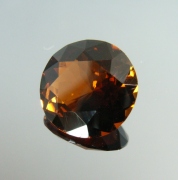 |
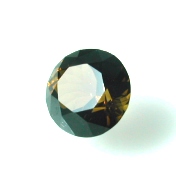 |
 |
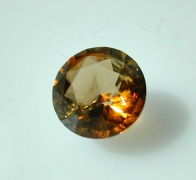 |
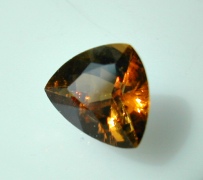 |
| ウヴァイト(Uvite) 1.85ct ø8.3mm 2ct ø8.1mm Ratnapura, Srilanka |
ウヴァイト結晶 (Uvite crystal) Uva, Srilanka |
ドラヴァイト(Dravite) 2.78ct ø9mm 1.76ct 8.7x7.7mm Srilanka | ||
ウヴァ地方が原産ですが、写真のような結晶を見る限りでは初生鉱床で発見されるようです。
しかし実際にカットされるものは主にラトナプラ産の水磨礫が大半です。
非常に重く暗い色合いで到底宝飾品用途には使えそうもありません。
一方ドラヴァイトのほうは最近人気のブラウン・ダイアモンドのような明るい褐色でなかなか魅力があります。
The name originates from the first discovery at famous tea locality ; Uva Province, south-eastern heights of Srilanka. Seen from crystal specimen, uvite of this original locality seems to be mined from primary deposit. However, almost all facetted stones are from Ratnapura, alluvial deposits. But facetted uvites are generally too dark to be used for jewlery purpose, while drivite, closer brother of uvite, has much lighter and pleasant tone, like brown diamond.
ブラジル・バイア州・ブルマードのウヴァイト(Uvite from Brumado, Bahia, Brazil)
 |
 |
||
| 0.33ct 5.5x3.5mm
1.51ct 8.5x5.9mm Brumado, Bahia, Brazil |
|||
現在市場で時々見かけるのはブラジル・バイア州・ブルマードのマグネサイト鉱床の晶洞からの見事なウヴァイト結晶です。
非常に複雑な化学組成に加えて鉄、マンガン、チタン、ナトリウム、クロム、ヴァナジウム、さらに亜鉛の痕跡までが不純物として含まれるために暗緑色から暗赤色まで多彩な色合いを帯びています。
大きく見事な結晶を産しますが不透明なためカットされることは稀です。
今回入手した黄緑色のカット石は0.33カラットと小さなものですが珍しく透明度の高い黄緑色です。
チェルシーフィルターに反応して淡いピンクとなり、鉄の他にクロムかヴァナジウムを含む着色をうかがわせます。
赤褐色のルースは内包物のために殆んど不透明ですが、強い透過光線では透明度を示します。
Most of uvite specimen we enconter in mineral markets comes from magnesite pockets of Brumado, Bahia, Brazil. They show dark green to dark red, due to impurities of ; iron, mangan, titanium, chrome, vanadium and even traces of Zinc. Thanks to the growth in magnesite pocket, crystals are well terminated in relatively bigger size. But Brumado uvites are rarely facetted because of dark tone and impurity.
Light yellow-green stone is although small but transparent. This stone reacts to pale pink through chelsea filtor, which suggests that coliring agent is chrome or vanadium, in addition to iron.
ブルマードのウヴァイト結晶(Uvite crystals from Brumado) マグネサイトと水晶を伴うウヴァイト結晶群 60x40mm
Uvite crystal aggregate with magnesite and quartzマグネサイト上の結晶 (Uvite crystals on magnesaite)
左(left) 13x9mm 中央(center) 20x15mm 右(right) 19x16mm
ビルマのウヴァイト(Uvite from Burma)
 |
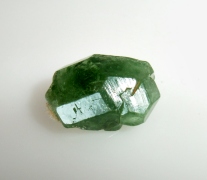 |
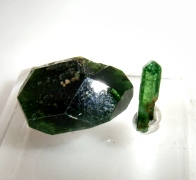 |
|
| Vanadium
Uvite 16x12x12mm 12x7x6mm Mogok, Burma |
Vanadium
Uvite-Drivite left 14x10x5mm right 10mm Burma |
||
ビルマのシャン高原、サルウィン川西岸のカレンニ丘陵に20世紀初頭に鮮やかな緑色の結晶が発見されました。
当初は透輝石、次にエメラルドではないかと考えられましたが、後にクロム発色のウヴァイトードラヴァイト・トルマリンとされました。
しかし最終的にはクロムではなくヴァナジウムによる発色と分かりました。
カレンニ丘陵からはその後の産出の報告は途絶えていましたが、1997年に新たにモゴクで発見された一つの晶洞から鮮やかなエメラルド色の平板状、柱状、薔薇の蕾状と多彩な結晶形を示すウヴァイトードラヴァイトを産出しました。
半透明の小さな結晶でカットには至りません。チェルシー・フィルターを通して暗赤色を示し、恐らくカレンニ丘陵産と同様にヴァナジウムによる発色と思われます。
In early 1900, bright green mineral was discovered at Karenni Hills along western bank of The Salween River in Shan Plateau, Burma. This mineral was first considered as diopside, next emerald, and finally chrome-tourmaline. The chromogene was identified not chrome but vanadium. There were no report of production from this locality. In 1997, at one pocket of Mogokl produced bright green uvite-drivite with tabular, prismatic and rose-bud like varieties of crystal form. They are too small and semi-transparent and not suitable for facetting. All crystals react to chelsea filtor and turn to dark red color, which suggests the vanadium contents as well as Karenni one.
| Top | Gem Hall |